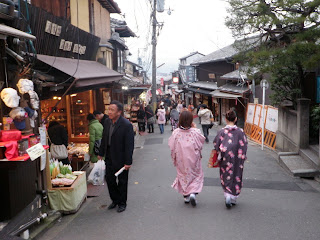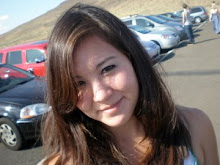had amazingly gorgeous weather for a few days, which has been a nice
welcome to the start of my settled life here. After 52 days, seven
countries, fourteen cities, 24,000 miles, and 18 flights, I have to
admit that it’s nice to have my own bed and not to live out of a
backpack any more. Before I get too carried away with life at home,
though, I’d like to finish up this blog with accounts of my time in
Korea – ending in Seoul – or as they call it: “The Soul of Asia.”

After our speedy (whale encounter free) ferry ride, we ended up in
Busan, Korea. From there we found our way to a subway, and then a bus
and about two hours later to the Gyeong Ju bus station. We wandered
around with our heavy stuff for far too long and eventually convinced
a reluctant cab driver to take us to our hostel. SaRang Chae was
described in the book as “the best hostel in the country.” At this
point we’ve realized that the meaning of “best” can be highly
subjective when it comes to hostels, and Gyeong Ju is pretty small, so
we weren’t really sure what to expect. This hostel is nestled between
a lot of narrow little alleyways and a massive park of hill shaped
tombs. It’s made up of a bunch of traditional style rooms all facing
in towards a courtyard where a couple of big dogs are constantly
napping. Our room was pretty large, but instead of beds, we were
given two sets of thin pads, blankets and pillows to unfold and sleep
on. The bathroom had a western style toilet and a showerhead attached
to the wall, but no sink. It was very clean, just much sparser than we
expected. The ambiance was great though and the couple that runs it is
very sweet and helpful. Also, surprisingly for the time of year, it
was pretty full of guests –from America, Canada, and Britain. The
first night we spent there, we discovered that the floors are
mysteriously heated. Our book said that it’s the traditional way of
heating using fire under the buildings. It sounds pretty dangerous,
but it definitely made it more comfortable. The hostel also puts out
bread, eggs, and jam in the morning so that you can fix your own
breakfast for free. It was kind of nice and homey to be able to make
food for ourselves for the first time in a few weeks.

When we woke up the next morning, it was grey and drizzling, but we
were only there for one day so we borrowed umbrellas and set off to
see the sights anyway. First on the list was Bulguksa, an ancient
temple complex from the Silla dynasty. It was about half an hour bus
ride outside of town, and consisted of a raised, walled-in area with
Buddhist temple buildings and Silla style pillars. There was also a
very pretty drum on a turtle. After that we came back to our hostel
area to the Tilimum Park where a lot of the Silla kings are buried and
went into the only tomb open to the public – the Changma tomb. A very
friendly free English-speaking tour guide met us outside and took us
through, explaining everything. All of the artifacts displayed in the
tomb are actually fake versions, replicas, but you get to see the
traditional layout and what the inside of all the hills are filled
with. There’s a wooden chamber at the center – at ground level, which
is covered by a huge mound of rocks (to prevent burglary), and then a
layer of clay around the rocks covered with dirt and grass. The tour
guide said that this king’s name is unknown, but that a painting found
in the tomb of a horse inspired the naming of the tomb as the
“Heavenly Horse Tomb.” Apparently this king was the first to decide
not to have a group burial, which consists of a number of people being
buried alive with the king’s coffin. How sweet of him. The Silla
dynasty ran for about 1000 years uninterrupted and had three queens
who ruled.

After that we trekked to the National Museum, which is very nice and
large and has free admission. Unfortunately, by the time we got there
we were soaking wet, so it wasn’t as enjoyable as it should have been.
All the real original artifacts unearthed from the tomb we had seen
were there, including a very impressive gold crown with little jade
“commas” hanging from it. Our tour guide had told us that they
represent embryos and therefore fertility. After seeing a famously
large and melodious bell and some other artifacts, and being mistaken
for a Korean by some people from our hostel, we headed back to change
and rest for a while.

The food we had in Gyeong Ju was traditional Korean style, where each
person gets a small bowl of fish, meat, or tofu with a bowl of rice,
and then there are a lot of little shared veggie dishes including
kimchi. Carly didn’t really like not knowing what everything was, so
we also found a place called Paris Baguette, which had amazing French
style pastries and little baguette pizzas.

During our time in Korea, the 2010 winter Olympics in Vancouver were
going on, and the star both locally and abroad was the charming
19-year-old ice skater, Kim Yuna. After she won the gold, all the
Koreans called her “Queen Yuna” and her pictures were all over the
place. They also played her long program skate on repeat during our
whole 5 hour bus ride to Seoul the next day. Yuna seems very humble
and sweet and it’s hard not to be instantly in love with her. We were
definitely rooting for her. I probably have her routine memorized at
this point, and never really need to see it again.

Our Seoul hostel was highly recommended by my book, and the book
provided a map and very clear instructions of how to get there.
Everything went really smoothly, until we came to the location that it
was supposed to be – and it was nowhere to be found. After we wandered
around and got very sore backs from lugging our stuff everywhere, a
young Korean man approached us. He asked us in very good English if we
were looking for a backpacker’s hostel. Relieved, we told him we were,
and showed him the map and the name and number of the place. He
called them up, and then told us that it was very far – probably a
15-minute drive from where we were. I was a bit skeptical. We had
followed the directions exactly and our location exactly matched up
with the map. I figured we had just not seen it down one of the
alleyways. After looking around more and deciding it definitely wasn’t
there, our new friend jumped in a cab with us and took us to the real
location. He said he had a test in accounting the next day but not to
feel sorry for him because he had given up studying anyway and didn’t
want us to get ripped off by a cab driver. It turns out, the hostel
had moved two years ago, right after my book was published. We were so
grateful when we found the place that we took him to dinner at a
nearby fast food Korean place (classy, I know). His name is Ilnam and
he studied abroad in Alabama for about 10 months last year and is
still mourning the end of his relationship with an American girl,
which is why he hasn’t studied much for his exam. He was very sweet
and brought us little Korean pouches as presents later in the night to
thank us for dinner. He used “ya’ll” when he wrote on our facebook
walls later too, which we found very entertaining.

That night, at Ilnam’s suggestion, we went to see the Seoul Tower. We
were kind of towered out at this point, but it was definitely the most
exciting tower we saw on the trip because you take a cable car to get
there. The tower sits on the top of a big hill in the middle of the
city, so it has a 360-degree amazing view. It’s apparently the most
romantic place in Seoul.

The next day was our last full day of the trip, so we started off
earlier than usual and went to the GyeongbukGung palace. It’s the most
popular of the 5 palaces in the city and has been restored a lot since
the Japanese destroyed it during the war. All of the old buildings in
Korea are very similar to ancient Chinese architecture, with some
differences in color schemes and patterns. The characters on the
buildings are all Chinese though, because apparently the Koreans used
the Chinese writing system until the 1940s or so. After the palace we
went to the Namdeomung market, which happened to be right by our
hostel. Since it was our last day, we decided that we were allowed to
shop and we bought a few fun knock off socks and scarves and the like.
I got a sweatshirt that says “Proud to be a bunny hugger” that I love.
The vendors in the market quoted us really high prices that were all
the same and didn’t seem to budge when we tried to bargain. I got the
feeling that the prices they told the locals were much lower, but I
guess that’s what I get for not being able to speak Korean.

Our last Korean dinner was delicious Korean BBQ, and then that night
we met up with a friend from Seattle named Liz. She’s teaching English
in Seoul for a year and took us out to Hongdae (the big bar scene)
with her other expat and teacher friends. It was really fun to see her
and get a sense of the international scene in Seoul.
I didn’t expect to dislike Korea, but I was definitely pleasantly
surprised by it. It’s very easy to travel there – especially in Seoul
there are a lot of English speakers and everything is well labeled and
easy to figure out. It’s a bit more expensive than China, but cheaper
than Japan. Seoul is very cosmopolitan and has a youthful and fun
vibe. I was really glad that we got to see Gyeong Ju too, though. It’s
a much smaller city where everything is within walking distance and it
doesn’t seem very permeated by Western influence and travelers. Gyeong
Ju and Seoul complimented each other nicely – giving us a broad, but
quick, introduction to Korea. I definitely want to go back sometime
and explore more.
Well, it’s really been a crazy and amazing adventure. I think the best
but also most frustrating part of traveling is how much it makes you
want to see more of the world. For now I’m happy to be settling in to
Seattle and excited for my next big adventure – joining the real
working world. We’ll see how long that excitement lasts. ☺ So, it is
with bitter sweetness that I must declare this story officially over…
but…
Expect to see more of me, world! I’m not through with you yet.











































